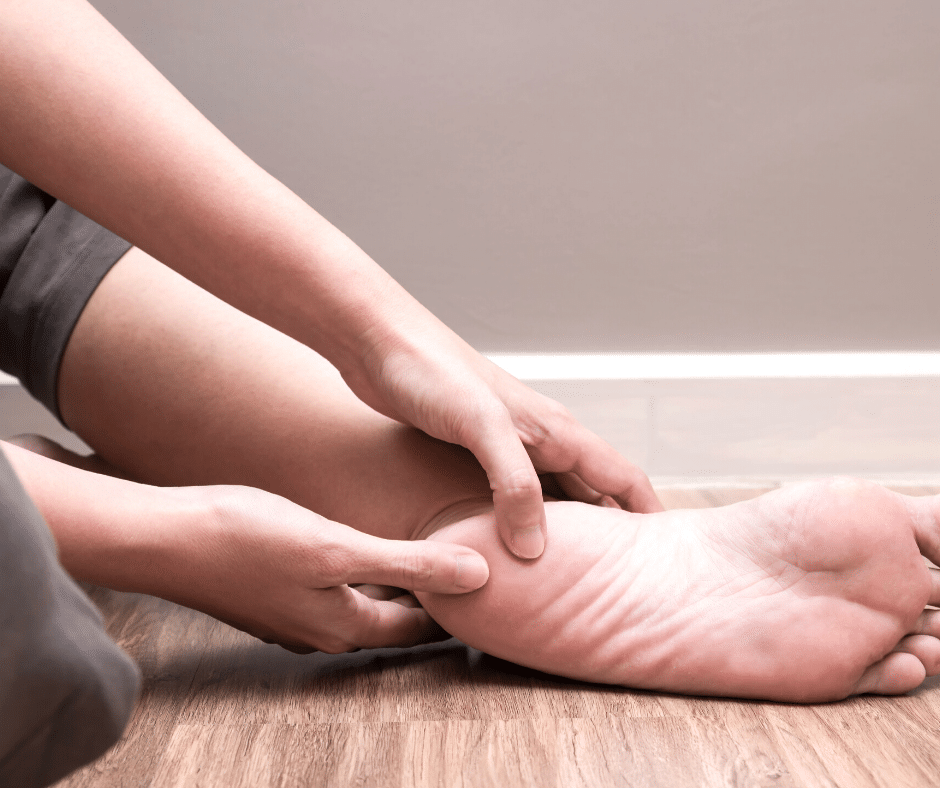Our feet are an integral part of our bodies which are often abused and taken for granted…until they hurt. The foot is a flexible and complex arrangement of bones, joints, ligaments, tendons, muscles and soft tissues that allow us to stand upright. The feet not only function as supports that allow us to stand, they are important in maintaining balance and their muscles influence our ability to produce forward propulsion. They have to adapt quickly to the varied surfaces upon which we walk, run, and jump and are key to our ability to walk and run with an upright posture – highlighting their role in bipedal locomotion.

Podiatry Care
Dr. Richard Erbes, DPM, describes a podiatrist as a “medical specialist that treats diseases, deformities, and fractures of the foot and ankle.” There are many issues that arise that can affect the function in your feet and ankles. One that Dr. Erbes sees often is plantar fasciitis.
Plantar Fasciitis
A common foot ailment many patients suffer from is called plantar fasciitis. According to Dr. Erbes, plantar fasciitis is the “thickening and inflammation of that band (plantar fascia) on the bottom of the foot” and causes pain primarily “at its point of insertion on the heel.”
What is the Plantar Fascia?
The plantar fascia is a fibrous band on the bottom of the foot. It connects the heel bone to the toes, so it runs from the heel to the ball of your foot. Its function is to raise the arch of your foot as it pushes off the ground.
Signs & Symptoms
Dr. Erbes notes that patients with plantar fasciitis will have “pain when first arising in the morning or sitting for a while”. They may also have pain after long periods of walking or standing. This pain is normally in the bottom of the heel and may be intense. Besides intense heel pain, patients may experience stiffness and pain in the arch of the foot and/or under the heel.
Causes
“Overuse, and pounding on hard surfaces” are what Dr. Erbes believes are the primary causes of plantar fasciitis, but it can become irritated if your foot flattens too much as you walk. It may also be caused by a sudden increase in activity level, or inadequate warmup prior to working out.
Risk Factors include:
- Flat feet
- High arched feet
- Being overweight or obese
- Prolonged standing
- Shoes that don’t fit well and don’t provide adequate support
- Poor physical conditioning
- Increase as we age
Treatments
Plantar fasciitis can be stubborn. The longer it has been present, the longer it may take to get better. Dr. Erbes states that treatments may include “ice, stretching, orthotics, injections, surgery, and/or PT (physical therapy).”
Prevention
Prevention is always the best medicine. It is vitally important that you wear shoes with good arch support. Dr. Erbes recommends you “get off your feet occasionally and wear good supportive shoes.” Once your feet are feeling better, you may continue recommended exercises and stretches to prevent future problems.
Podiatry Care for Your Feet and Ankles
Visit a podiatrist for your pain if you experience any of the following symptoms:
- Swelling of the foot
- Numbness and loss of feeling
- Tingling (pins and needles feeling)
- Spreading redness, red streak, warmth
- Pain around big toe joint
- Poor blood flow and circulation
- Soreness
- Muscle cramps
- Discoloration of foot
- Infection
If you are dealing with any foot issues or pain, let Dr. Erbes help you get back on your feet, and stay on your feet! Learn more about our Podiatry Services by clicking here or call 507-238-4968 to schedule an appointment with Dr. Erbes at Windom Area Health.
By Brenda Muller, Outreach Clinic Manager

